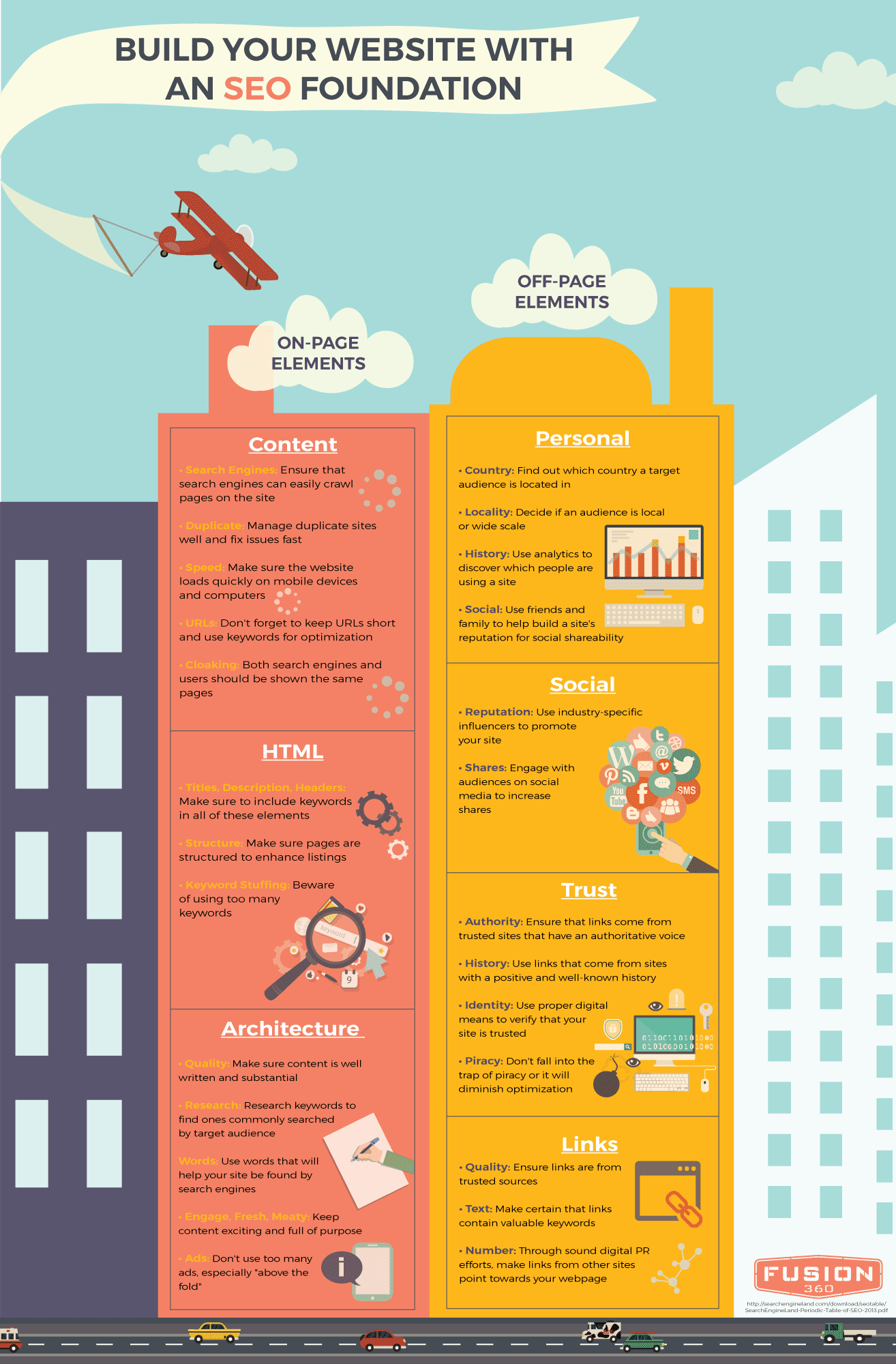Search engine optimization (SEO) can seem like a foreign language, especially to those who are first diving into building a website. The trick is to get down the basics of SEO construction. Once all the right foundation blocks are in place, the rest can quickly be built from there.
There are two separate types of SEO to understand before attempting to optimize a website. The first are on-page factors. These will be the content or keywords that are built into the website and are under the direct control of the publisher.
Once that is established, the off-page factors come next. Those are the elements that are influenced by other readers, visitors and publishers from around the world. Smaller building blocks within these two structures will ultimately build a site that is SEO ready.
On-Page: Content
The first place where SEO can be built in for maximum optimization is the content. This may seem obvious, but there are certain elements that must be included for content to be successful. The pages must all be full of quality content—things that will interest the right audience.
Once you’re sure that the content has purpose and intrigue, use research to find keywords that will most likely be searched by your target audience. Google AdWords is a great tool that can make this process quick and easy.
Make sure the researched keywords match up with the words you hope your website will be searched for. They must match up with the purpose of the website. If not, the keywords will be obvious and out of place.
From there, tweak content to make it engaging, in line with trending topics and full of actual substance. No one wants to read something they already know about. Don’t forget to also minimize ads, especially “above the fold” where most viewers hang out on the webpage.
On-Page: HTML
Once content is created, HTML comes next to display it all on the website. However, don’t just develop HTML without considering how SEO can play a part. Use geo-qualifiers with your HTML to draw in locals, or use other words that will seek out larger target audiences. Make sure to include these types of keywords in the title, description and headers on your webpage. That being said, beware of keyword stuffing. When keywords are used in abundance, it’s likely that a digital penalty be issued. As a result, PageRank suffers.
Finally, make sure the pages are structured in a way with data that will enhance listings. Incorporate all of these techniques into your HTML, and you will find that the site’s ranking significantly goes up.
On-Page: Architecture
Everything that is built needs some sort of architecture. It is the mechanics that make a house—or in this instance, a website—function. Although the audience can’t see it, they will notice if the architecture is lagging.
Incorporate SEO into this architecture to make sure viewers are unaware of any “bugs.” The first way to do this is by ensuring that search engines can easily crawl pages on your site. Most people, regardless of where they come from, use search engines for andy and all web browsing.
Duplicate content can also be a common issue. How does the site manage this duplicate content? Make sure it is optimized for a quick fix. It is also important to make sure the site loads quickly—on mobile devices and computers. Viewers will not stick around past three seconds, so this aspect of SEO is vital.
Steer clear of “cloaking” pages to show up differently to search engines and humans. People want what they think they are going to get. Finally, make sure URLs are short and include keywords. This will take architecture to the next level.
Off-Page: Links
On the flip side, off-page factors are still important, although they may not be directly influenced by the publisher. Start by making sure links are from trusted sources. This will persuade more viewers to trust enough to give your link a click. Don’t forget to include in the text of links important SEO keywords for optimization. Also, it is a good idea to ensure links on other websites point back to yours.
Off-Page: Trust
Dive down deeper into the trust aspect of your links. People want to know they can trust what they read. Only use links that have authority or a good history already established. That way being associated with that source will enhance your site’s own authority.
Take it a step farther and use sources that can stamp your site with a trusted identity. Meanwhile, keep in mind that being flagged for piracy will never reflect well for your SEO optimization. Keep it honest and trusted with legitimate links.
Off-Page: Social
Never forget to incorporate social media into your SEO strategy. This is extremely important nowadays with millennials who spend most of their days on such sites. Use social media influencers within your target audience’s social circle to promote your site. It is also a good idea to engage with your audience on social media to influence more shares and spread the word faster about your site.
Off-Page: Personal
After a website is built with the aforementioned foundational blocks, circle back with analytics. Find out who is visiting your site and learn more about your target audience to increase their viewership. Consider things like where in audience is coming from, if users have visited the site before and if you are tapping into their influencers for help. SEO should never be left out of website development.
Needless to say, using these building blocks can take an unsuccessful attempt at constructing a website and transform it into an easy way to spread the word about your product or service. Don’t take any chances—incorporate SEO.



